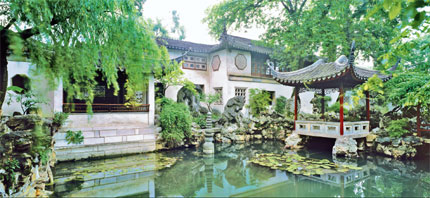Suzhou's old town a cherished oasis of tranquility
 |
| Humble Administrator's Garden is one of China's Four Famous Gardens, and is the largest garden in Suzhou, Jiangsu Province. [Shanghai Daily] |
Suzhou in Jiangsu Province is a model for urban preservation of its ancient town with quaint streets, classic gardens and waterways. The city is featured in the World Expo 2010 Shanghai as an example of perfectly balancing ancient and modern.
Visiting the legendary city of Suzhou with a history of more than 2,500 years, one is impressed by the classical gardens, the winding streets and bridges, the simple black, gray and white architecture.
Leaving the bustling modern city of Suzhou, one is transported back in time to an enclave without skyscrapers, neon and contemporary intrusions.
The government of Suzhou in Jiangsu Province is dedicated to cultural preservation and restoration of sites that all travelers can enjoy.
Shantang Street
Wooden boats, stone bridges, cobbled walkways and white houses with black tile roofs along the riverbank evoke memories of old Suzhou. The Old City is filled with streets that are well preserved or restored to replicate the originals.
Shantang Street is one of the most typical Suzhou-style streets with multiple waterways and crossed by bridges. It is situated beside the Shantang River and connected with other streets by stone bridges. It features many arcades with delicate decoration.
The street has been paradise for merchants nationwide since the Tang Dynasty (AD 618-907).
Residents living above shops could lower baskets to street level and shout down to vendors to fill them with whatever they needed - then they'd raise the baskets. They could truly shop from home.
The market area includes the river plied by barges, cargo boats and smaller vessels selling rice, firewood, snacks and spices to people along the banks.
Though stores are no longer on the banks, visitors can ride in tour boats.
Shantang Street dates back more than 1,100 years.
It was first set up in the Tang Dynasty when Bai Juyi, a famous poet, was appointed prefectural governor in AD 825. While trying to make his way by boat to Hu Qiu, or Tiger Hill, Bai found the way obstructed and decided to construct a canal and street to facilitate travel.
The street and river extend seven li (a little more than 3 kilometers) from Duceng Bridge at the Chang Gate in western Suzhou to Tiger Hill. The river was named Shantang River while the parallel street was named Shantang Street.
The canal and street construction facilitated transport and irrigation and contributed to the city's prosperity.
To show their gratitude, residents built a temple for Bai and renamed the street Baigong Di (Sir Bai's Causeway) when Bai left his post.
 0
0 







Go to Forum >>0 Comments